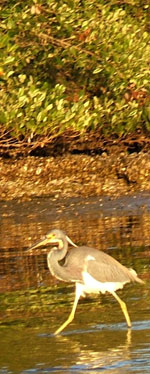Nature Does It Best
Then there’s the example of Palm Beach County, mentioned by the Herald-Tribune, which has dredged its way through a passel of island restoration projects in the 20-mile long Lake Worth Lagoon. (Note its name: it’s a “lagoon.” Unlike Sarasota’s natural bay, where salt and fresh water have mixed for thousands of years, the Lagoon at Palm Beach is an artificial bay, still in the teething stage since its creation a mere 150 years ago, when cuts were made to permit entry of ships into what had been a fresh water lake near the ocean. When it rains, fresh water floods the Lagoon from canals that were dug to drain the land. Those flows cause the Lagoon’s salinity to swing erratically—a danger to young sea creatures, in contrast to the more tender care generally provided by Sarasota’s bays.)

Edwards Island
One of Palm Beach County’s naturalists was quoted by the Herald-Tribune as, in effect, taking Sarasota to task for being too timid and slow to get with the island restoration dredging program, which he said was “settled science.” But neither he nor the article mentioned two important points: 1) Roberts Bay doesn’t suffer from the major ills targeted by the Palm Beach projects, and 2) Palm Beach County’s signature project, the 79-acre Peanut Island restoration, didn’t at all diminish the beach, boating or recreational use of a a popular island destination. Rather, much of the $13 million spent on Peanut Island was used to expand use of the island’s popular county park by building hundreds of feet of boating docks, a snorkeling pool, 1.25 miles of paved brick walkways—plus a 23-acre storage area used for dredging material. All wonderful, no doubt, but not what’s needed in Roberts Bay and not what’s usually meant by “science.”
Helpfully, Palm Beach County describes the purposes of its projects (not the drawbacks, but at least the goals are published). So let’s take a look at the description by that County’s Department of Environmental Resource Management of the project that most nearly resembles (in size and layout) what some have imagined for Big Edwards, namely, John’s Island.
The Dead Zone: Plain Out of Muck
- There’s a “dead zone” on the bottom of the Lake Worth Lagoon, devoid of seagrass but covered with organic “muck.” When it rains, those inland canals act like giant pea-shooters, pushing muck into the narrow Lagoon that’s lined with buildings on both sides (there are nearly four times more people in Palm Beach County than in Sarasota County). Solution: cover up the Lagoon’s mucky bottom near John’s Island with thousands of tons of limestone rock dumped into shallow water. Over time, oysters should build a reef on those rocks. Cost: about $730,000 for the 5-acre first phase, or $146,000 per acre. For John’s Island, this may be perfect, but in Sarasota, Big Edwards Island already has 1) A natural oyster reef on its west side, anchored by nature-planted mangroves, not imported rocks); 2) A natural oyster shallows that fans out from the mangroves on the island’s northwest side; and 3) Adjacent oyster flats in the Bay to the southwest. And NO muck. Sarasota’s cost per acre for the oyster habitat surrounding Big Edwards Island: $0.
- Another announced benefit of the John’s Island project is donation of sand, an amount equal to about 1½ football fields piled five feet high, to help reshape 100 acres of the Lagoon’s bottom about a mile to the south, next to the city golf course. There, seagrass and mangroves didn’t like the deep, scarred bottoms. So a massive construction project called the “Snook Islands Natural Area” was conceived to raise up the bottom there by adding sand. In all, more than 100 football fields of sand piled 5 feet high were barged to the Snook area as a base for seagrass over more than 40 acres. The imported sand was also used to combat shore erosion, create four speck-sized islands, and build slopes for hand-planted mangroves against the golf course’s pilings. (To shelter the new mangroves and their sandy bed from waves and currents 28,000 tons of limestone boulders were also spread around)
Where did they get the sand they needed to cover all those acres? It was sliced off the tops of older spoil islands, including the sprawling Peanut Island, and the smaller John’s Island and others. When they sliced, they also removed “exotic vegetation” from the amputated islands. Costs of the Snook Area project: about $18 million, or roughly $180,000 per acre. Afterwards, says Palm Beach County, seagrass did begin to settle in, and fishermen caught more snook. These Palm Beach projects are popular ones, and perhaps they are exactly what’s required to grow seagrass, mangroves and snook habitat in that area’s artificial bay.
But Sarasota is much luckier. Roberts Bay is already a paradise for snook —no need to first build a “Snook Islands Natural Area.” Seagrass plants itself naturally on the bottoms of Sarasota’s natural bays (if currents aren’t diverted by “restoration” projects and if the water’s not clouded)—no need to strip sand from islands to manufacture “natural” bay bottoms. Muck and “dead zones” are not issues in Roberts Bay. In the narrow Lake Worth Lagoon, they dump boulders to protect new mangroves (as at the Snook Area and John’s Island). But in the sheltered tidal coves and channels on Big Edwards Island, nature’s mangroves are already flourishing--no hand-planting and no boulder breakwaters required.
Kenneth M. Pierce, now retired in Sarasota, FL, began his career in publishing as a journalist, winning awards at Time Magazine, co-founding the Chicago Journalism Review, and editing the Columbia Journalism Review. His past consulting clients include National Wildlife Magazine.